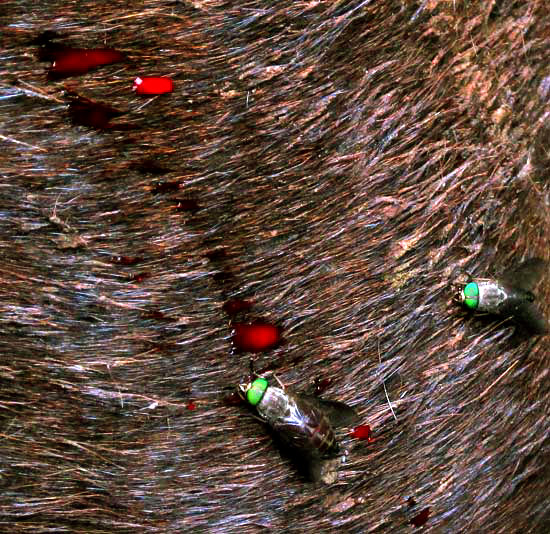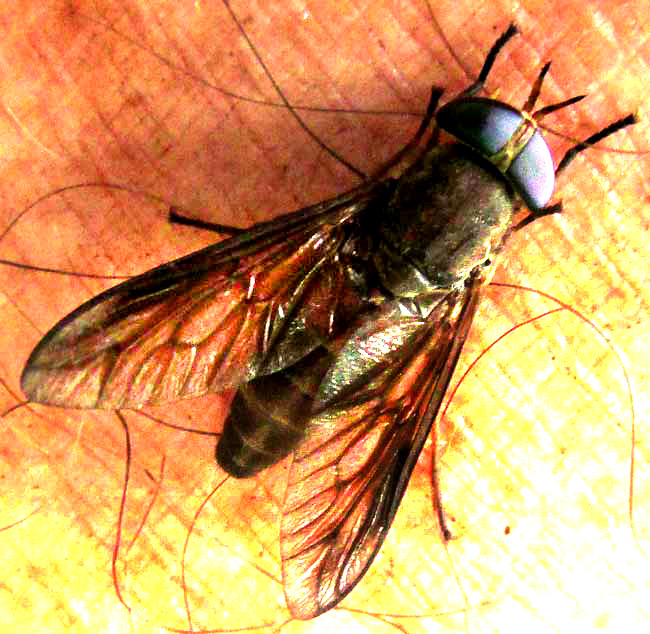Excerpts from Jim Conrad's
Naturalist Newsletter
from the July 30, 2017 Newsletter issued from Rancho Regenesis in the woods ±4kms west of Ek Balam Ruins; elevation ~40m (~130 ft), N20.876°, W88.170°; north-central Yucatán, MÉXICO
HORSEFLIES
Whenever and wherever livestock grazes, you're going to have horseflies. At the rancho with its cattle and burros, you can find them throughout the year, and it seems to me that lately they've been particularly mean. When I jog at dawn they settle on my back and legs; even when I'm biking a few attach themselves and start cutting away. My horsefly miseries are nothing compared to the livestock's, however, as a shot of a small patch of burro hide testifies below:

As that picture was being taken, one landed on my leg, and a close-up of that one appears below:

I was able to swat at the ones plaguing me so they seldom drew blood. The poor burros' defenses were limited, however. With their tails they could flail at those toward their rear ends, and they could throw their heads back and against those on a small portion of their shoulders, but otherwise large parts of their bodies simply couldn't be reached. Stomping their feet and kicking helped a little, but their main defense for places out of reach with the tail and head was to shiver or shimmy their skin, which they could do surprising well. They must have special muscles attached to their skin enabling them to quiver without moving their body parts. Shimmying caused many horseflies to move on, but if one really wanted to feed, rippling skin didn't stop them, and they'd settle and drink all they wanted, and leave blood oozing from their cuts.
Back in Texas where a microscope was handy, I got a good picture of a horsefly's head, emphasizing the mouthparts. It's at www.backyardnature.net/n/13/130721tc.jpg
In that picture, the downward-directed, paddle-shaped item is the labium, with which the fly sops up liquid, including blood. The labium is like a sheath wrapping around slender, sharp knife blades with which the fly can slash through skin to get at blood. In the head picture, the sharply pointed, brown item between the labium and the antennae pointed to the picture's right border is one of two maxillary palps, which help the fly feel and maybe smell/taste whatever they touch.
Of course I wanted to identify the flies in the above pictures, which seem to be of two different species. However, the world of horseflies is a big one spread through several genera. For orientation on horseflies in the Yucatan I was lucky to find a PDF document on the Internet dealing with horseflies of the Yucatan, in Spanish (in which language they're called tábanos, and {used to be} downloadable for free.
That undated document, authored by Pablo Manrique Saide and others, says that worldwide the Horsefly Family embraces about 4290 species, with 207 of those species turning up in Mexico, and 25 in the Yucatan Peninsula. The document also says that along the Yucatan's coast the yellowish Diachlorus ferrugatus is the dominant species, so probably that's the one that pestered us so unrelentingly during our 2011 summer on the Caribbean north of Mahahual. After that, the dominant species are members of the genus Tabanus, especially Tabanus commitus.